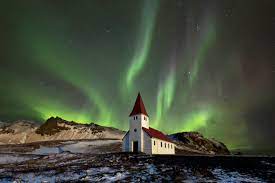The aurora is a spectacular natural light display that can be seen in the northern hemisphere, also known as the Northern Lights. It is caused by the interaction of charged particles from the sun with the Earth’s magnetic field. The aurora occurs most frequently in high latitudes, in regions around the Arctic Circle, but can sometimes be seen as far south as the United States.
The colours of the aurora are caused by the different types of charged particles that enter the Earth’s atmosphere. Green light is produced by oxygen molecules, while red light is produced by nitrogen molecules. The aurora can also appear as shades of blue, pink, and purple.
The aurora is a breathtaking sight that has inspired artists and scientists alike for centuries. It has been the subject of many myths and legends, and has been studied by scientists for its effects on the Earth’s atmosphere. The aurora is also a popular tourist attraction, with people traveling from all over the world to see it.
In addition to its beauty, the aurora has practical applications. The charged particles that cause the aurora can also interfere with satellites and power grids, so studying the aurora is important for understanding and mitigating these effects.
Overall, the aurora is a wonder of nature that continues to amaze and inspire us.
The scientific explanation of the aurora
The aurora, also known as the Northern Lights, is a spectacular natural light display that occurs in the Earth’s polar regions. The phenomenon is caused by the interaction of charged particles from the sun, also known as solar wind, with the Earth’s magnetic field and atmosphere.
When the charged particles from the sun collide with the Earth’s magnetic field, they are deflected towards the poles. As these particles enter the Earth’s atmosphere, they collide with gas particles such as oxygen and nitrogen. The collisions excite these gas particles, causing them to emit light of various colours, which we see as the aurora.
The colours of the aurora are determined by the type of gas particles that are being excited. Green light is produced by oxygen molecules, while red and blue lights are produced by nitrogen molecules. Pink and purple colours are also sometimes seen.
The intensity of the aurora can be affected by the strength of the solar wind, which is influenced by the sun’s activity. During periods of high solar activity, such as during solar flares or coronal mass ejections, the aurora can be seen at lower latitudes and may appear more intense.
In addition to its beauty, the aurora has practical applications. The charged particles that cause the aurora can also interfere with satellite communications and power grids, so understanding the aurora is important for mitigating these effects.
Overall, the aurora is a remarkable natural phenomenon that continues to captivate scientists and enthusiasts alike. Its scientific explanation is a testament to the beauty and complexity of the natural world.
Cultural implications of aurora
The aurora, also known as the Northern Lights, has significant cultural implications in various parts of the world. For centuries, it has been a source of inspiration for poets, artists, and writers, and has been the subject of many myths and legends.
In some indigenous cultures, the aurora is believed to be the spirits of their ancestors, and is a symbol of renewal, rebirth, and connection to the spiritual world. The Inuit people of Canada and Greenland believe that the aurora is a celestial fire that is used by spirits to communicate with the living.
In other cultures, the aurora is believed to be a sign of good luck or a warning of impending disaster. In Norse mythology, the aurora was associated with the god Odin, and was believed to be a bridge between the world of the living and the dead. In Finnish mythology, the aurora was believed to be caused by a magical fox running across the sky, and was a sign of good luck for hunters.
The aurora has also influenced art and literature, particularly in northern regions. Many famous artists, such as Vincent van Gogh and Edvard Munch, have been inspired by the aurora and have created paintings and artworks depicting the natural phenomenon. The aurora has also been the inspiration for various literary works, such as the poem “Aurora Leigh” by Elizabeth Barrett Browning.
Today, the aurora is a popular tourist attraction, with many people travelling to see the natural phenomenon. It has also become an important part of cultural festivals in northern regions, such as the Aurora Festival in Yellowknife, Canada.
Overall, the aurora has played a significant role in the cultural history of many societies, and continues to be an important symbol of beauty, wonder, and spirituality. Its cultural implications serve as a testament to the enduring fascination and allure of this natural phenomenon.
